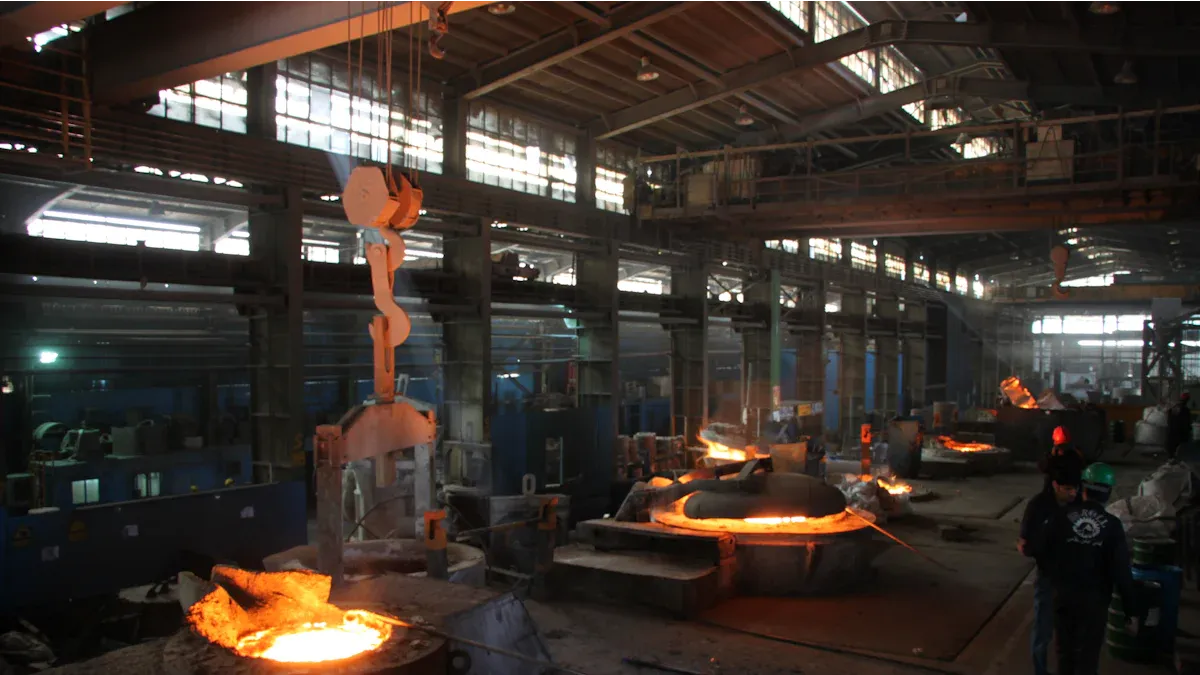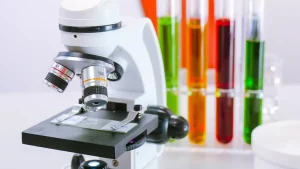
Global foundries are increasingly turning to Silicon Carbide Ceramic Coating to enhance the performance and longevity of diffusion process kits. This advanced material provides outstanding durability and thermal resistance, making it a perfect choice for high-temperature semiconductor manufacturing. Its remarkable properties help reduce wear and significantly extend the lifespan of components. Cutting-edge solutions like CVD SIC COATING and TAC COATING further boost production efficiency by minimizing thermal inconsistencies. Additionally, the implementation of CVD TAC COATING delivers exceptional chemical resistance, which is essential for withstanding harsh manufacturing conditions. These advancements enable foundries to achieve superior product quality while effectively managing operational costs.
Key Takeaways
- Silicon Carbide Ceramic Coating makes diffusion kits last longer, so they need fewer replacements.
- This special coating spreads heat evenly, creating better semiconductors and more products.
- Using this coating cuts maintenance costs and downtime, making production faster.
- Silicon Carbide handles heat and chemicals well, perfect for hot industrial uses.
- Choosing this coating saves energy and lowers CO2, helping the environment.
Diffusion Process Kits in Semiconductor Manufacturing

Role of Diffusion Process Kits
Diffusion process kits play a critical role in semiconductor manufacturing. These kits are essential for facilitating the diffusion process, a key step in creating integrated circuits. During this process, dopant atoms are introduced into a silicon wafer to modify its electrical properties. The kits ensure that this procedure occurs with precision and consistency, which is vital for producing high-quality semiconductors.
Each component in a diffusion process kit must withstand extreme conditions. High temperatures, chemical exposure, and mechanical stress are common in semiconductor fabrication. The kits act as protective barriers, preventing contamination and ensuring the integrity of the wafers. By maintaining a controlled environment, they contribute to the overall efficiency and reliability of the manufacturing process.
Importance of Material Selection
The choice of materials for diffusion process kits significantly impacts their performance and longevity. Materials must endure harsh conditions without degrading or compromising the process. Poor material selection can lead to frequent replacements, increased downtime, and higher operational costs.
Silicon Carbide Ceramic Coating has emerged as a preferred material for these kits. Its exceptional durability and resistance to thermal and chemical stress make it ideal for high-temperature applications. This coating minimizes wear and extends the lifespan of components, reducing maintenance requirements. Additionally, its ability to maintain temperature uniformity enhances process efficiency and product quality. Foundries adopting this advanced material benefit from improved yield rates and reduced production costs.
Material selection is not just a technical decision; it is a strategic one. Choosing the right materials ensures that semiconductor manufacturers can meet the demands of modern technology while maintaining cost-effectiveness and sustainability.
Advantages of Silicon Carbide Ceramic Coating

Superior Durability and Longevity
Silicon carbide ceramic coating offers unmatched durability, making it a preferred choice for diffusion process kits in semiconductor manufacturing. Its ability to withstand extreme environmental conditions ensures a longer lifespan for components, reducing the need for frequent replacements. This durability is particularly valuable in industries like aerospace, automotive, and electronics, where high-performance materials are essential.
A market projection highlights the growing demand for silicon carbide coatings, with the market expected to reach $1.5 billion by 2032, growing at a compound annual growth rate (CAGR) of 7.8%. This growth reflects the increasing reliance on durable materials that can resist oxidation, corrosion, and wear. Additionally, silicon carbide coatings are ideal for energy applications, as they perform exceptionally well in extreme temperatures and harsh environments. Their application in automotive powertrain components and battery systems further demonstrates their ability to enhance performance and longevity.
| Evidence Description | Key Points |
|---|---|
| Market Growth Projection | The SiC coating market is expected to reach $1.5 billion by 2032, growing at a CAGR of 7.8%. |
| Demand for Durability in Industrial Applications | Increasing demand for high-performance and durable coatings in aerospace, automotive, and electronics. |
| Protection Against Environmental Factors | SiC coatings provide excellent protection against oxidation, corrosion, and wear, enhancing longevity. |
| Suitability for Extreme Conditions | Ideal for energy applications due to their ability to withstand extreme temperatures and harsh environments. |
| Application in Automotive Industry | Used in powertrain components and battery systems to improve lifespan and performance. |
Thermal and Chemical Resistance
The thermal and chemical resistance of silicon carbide ceramic coating sets it apart from traditional materials. This coating can endure high temperatures without losing its structural integrity, making it suitable for applications like heat exchangers, turbine blades, and combustion chambers. Its small thermal expansion coefficient and high hardness contribute to its ability to resist thermal shock and wear.
Silicon carbide ceramic materials also exhibit exceptional chemical resistance. At temperatures as high as 1300 °C, the coating forms a protective silicon dioxide layer, which enhances its resistance to acids. However, it has limited resistance to alkaline substances due to the silica film. These properties make it an excellent choice for fire-resistant constructions, protective shells of nuclear reactors, and other demanding environments.
- Silicon carbide ceramic materials exhibit high-temperature strength and good wear resistance.
- They have a small thermal expansion coefficient and high hardness.
- They demonstrate thermal shock resistance and chemical corrosion resistance, making them advantageous over traditional coatings.
- At temperatures reaching 1300 °C, silicon carbide forms a protective silicon dioxide layer, enhancing its chemical resistance.
- It shows strong resistance to acids but has limited resistance to alkaline substances due to the silica protective film.
Enhanced Temperature Uniformity and Efficiency
Silicon carbide ceramic coating plays a crucial role in maintaining temperature uniformity during semiconductor manufacturing. This uniformity ensures that the diffusion process occurs consistently across the silicon wafer, leading to higher-quality semiconductors. The coating’s superior thermal conductivity allows for efficient heat distribution, reducing the risk of thermal inconsistencies that could compromise the manufacturing process.
When compared to other materials, silicon carbide demonstrates significant advantages. For instance, it offers better heat dissipation and higher reliability than gallium nitride. It also outperforms aluminum oxide in thermal conductivity and high-temperature resistance. These characteristics make it a more mature and reliable technology for high-temperature applications.
| Material Comparison | Advantages | Disadvantages |
|---|---|---|
| Silicon Carbide vs Silicon | 3x bandgap width, 10x breakdown voltage, higher operating temperature | 3-5x higher production costs, higher wafer defect rates, more complicated processing |
| Silicon Carbide vs Aluminum Oxide | Higher thermal conductivity, better electrical conductivity, stronger high temperature resistance | Higher cost, more difficult to process, more demanding manufacturing process |
| Silicon Carbide vs Gallium Nitride | Better heat dissipation, more mature technology, higher reliability | Poor high-frequency performance, larger volume |
By enhancing temperature uniformity and efficiency, silicon carbide ceramic coating contributes to improved yield rates and reduced production costs. Its adoption by global foundries underscores its importance in advancing semiconductor manufacturing processes.
Benefits for Global Foundries
Long-Term Cost Savings
Global foundries adopting silicon carbide ceramic coating experience significant long-term cost savings. This advanced material reduces the frequency of component replacements, lowering raw material consumption and operational expenses. Its ability to extend the service life of critical equipment, such as reactor vessels handling corrosive substances, minimizes the need for costly repairs and replacements. For example, silicon carbide coatings can extend the service life of such vessels by 60%, reducing replacement frequency and associated costs.
Additionally, silicon carbide ceramic coating enhances energy efficiency. By improving heat transfer efficiency by up to 15%, it reduces fuel consumption and lowers CO2 emissions. This not only cuts energy costs but also aligns with sustainability goals. Establishing a production facility for automotive-grade silicon carbide coatings requires an initial investment of $30-$50 million. However, the long-term savings in energy and maintenance costs justify this upfront expenditure.
| Evidence Type | Details |
|---|---|
| Capital Requirements | Establishing a production facility requires $30-$50 million in investment. |
| Energy Savings | Heat transfer efficiency improves by 15%, reducing fuel consumption. |
| Service Life Extension | Reactor vessels handling sulfuric acid see a 60% increase in service life. |
Reduced Maintenance and Downtime
Silicon carbide ceramic coating significantly reduces maintenance requirements and operational downtime. Its exceptional durability minimizes wear and tear, extending the mean time between failures (MTBF) for critical components. This leads to fewer interruptions in production, allowing foundries to maintain consistent output levels. For industries facing extreme wear, the coating can lower maintenance bills substantially.
Reducing downtime has a direct financial impact. Halving downtime can recover thousands of dollars monthly, emphasizing the strategic value of adopting silicon carbide ceramic coating. By enhancing the reliability of equipment, foundries can allocate resources more effectively, focusing on innovation and production rather than frequent repairs.
| Benefit | Description |
|---|---|
| Maintenance Cost Reduction | Ceramic coatings lower maintenance bills in industries with extreme wear. |
| Downtime Reduction | Extending MTBF reduces production interruptions and associated costs. |
| Financial Impact | Halving downtime recovers significant monthly revenue. |
Improved Product Quality and Yield Rates
The adoption of silicon carbide ceramic coating directly impacts product quality and yield rates. Its ability to maintain temperature uniformity during high-temperature processes ensures consistent diffusion across silicon wafers. This precision reduces defects, resulting in higher-quality semiconductors. Enhanced thermal conductivity further supports efficient heat distribution, minimizing the risk of thermal inconsistencies that could compromise product integrity.
By improving yield rates, foundries can maximize their production output without increasing operational costs. This efficiency translates into greater profitability and competitiveness in the semiconductor market. The coating’s chemical resistance also prevents contamination, ensuring that wafers meet stringent quality standards. Foundries leveraging this technology can deliver superior products while maintaining cost-effectiveness.
Real-World Applications of Silicon Carbide Ceramic Coating
Industry Examples of Successful Adoption
Industries worldwide have embraced Silicon Carbide Ceramic Coating to enhance operational efficiency and product reliability. Semiconductor manufacturing, for instance, has seen significant improvements in diffusion process kits. Leading foundries report reduced component wear and extended equipment lifespans, resulting in fewer production interruptions. This coating has also gained traction in the aerospace sector, where it protects turbine blades from extreme heat and oxidation. By maintaining structural integrity under harsh conditions, it ensures the safety and performance of critical components.
The automotive industry has also benefited from this advanced material. Manufacturers use it in electric vehicle powertrains to improve thermal management and durability. Battery systems coated with silicon carbide exhibit enhanced energy efficiency and longer service life. These real-world applications demonstrate the versatility and effectiveness of this coating across diverse sectors.
Hypothetical Scenarios Highlighting Benefits
Imagine a semiconductor foundry struggling with frequent downtime due to worn-out diffusion process kits. By adopting Silicon Carbide Ceramic Coating, the foundry could reduce maintenance needs and extend the lifespan of its equipment. This change would lead to fewer production delays and lower operational costs, ultimately boosting profitability.
In another scenario, an automotive company aims to improve the efficiency of its electric vehicle batteries. By applying silicon carbide coating to battery components, the company could enhance heat dissipation and reduce energy loss. This improvement would result in longer battery life and better vehicle performance, giving the company a competitive edge in the market.
These scenarios highlight how adopting this coating can address industry challenges, improve efficiency, and drive innovation.
Silicon Carbide Ceramic Coating has revolutionized diffusion process kits by delivering unmatched durability, thermal resistance, and cost efficiency. Its adoption by global foundries has led to significant advancements in manufacturing efficiency, sustainability, and product quality. These benefits position it as a critical material for addressing the challenges of modern semiconductor production. As the industry evolves, this coating will continue to play a pivotal role in driving innovation and maintaining competitive advantages.
FAQ
What makes silicon carbide ceramic coating superior to traditional materials?
Silicon carbide ceramic coating offers unmatched durability, thermal resistance, and chemical stability. It withstands extreme temperatures and harsh environments, reducing wear and extending component lifespan. These properties make it ideal for high-performance applications, outperforming traditional materials like aluminum oxide or gallium nitride.
How does silicon carbide ceramic coating improve semiconductor manufacturing?
The coating enhances temperature uniformity and thermal conductivity, ensuring consistent diffusion across silicon wafers. This precision reduces defects and improves yield rates. Its chemical resistance prevents contamination, maintaining product quality. These benefits streamline manufacturing processes and boost efficiency.
Is silicon carbide ceramic coating cost-effective for global foundries?
Yes, it reduces maintenance costs and extends equipment lifespan, minimizing downtime. Improved energy efficiency lowers operational expenses. Although initial investment may be higher, long-term savings in repairs, replacements, and energy consumption make it a cost-effective choice for foundries.
Can silicon carbide ceramic coating be used in industries beyond semiconductors?
Absolutely. Its versatility makes it suitable for aerospace, automotive, and energy sectors. It protects turbine blades, enhances electric vehicle battery systems, and improves heat exchangers. Its ability to perform under extreme conditions ensures reliability across diverse applications.
What are the environmental benefits of using silicon carbide ceramic coating?
The coating improves energy efficiency by enhancing heat transfer, reducing fuel consumption, and lowering CO2 emissions. Its durability decreases raw material usage and waste from frequent replacements. These factors contribute to more sustainable manufacturing practices.






